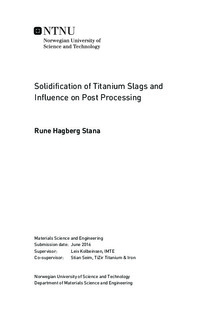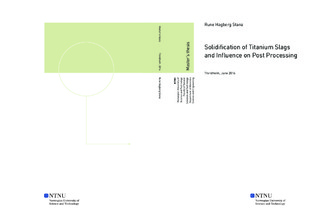| dc.description.abstract | Ilmenite is a titanium-rich ore, and accounts for almost all the world's consumption of titanium bearing minerals. One of the main uses of titanium is as powdered TiO2, used extensively as whitening pigment. The first step in the process of making TiO2 pigment, is reducing the ilmenite to a titanium-rich slag.
The titanium slag consists mainly of a titanium phase on the form of M3O5. The elements Fe, Mn and Mg can substitute Ti in the M3O5 lattice, and the slag also contains impurities such as SiO2, CaO, Al2O3, Cr2O3 and V2O5. The slag needs to be purified and processed to make the pigment end product. This thesis focuses on the stage after reducing the ilmenite to a titanium-rich slag, and before the further purification of the slag.
To get a better understanding of the properties of the solid slag after reduction in the blast furnace, both industrially collected and experimentally prepared samples have been analyzed. It is believed that the cooling rate and access to oxygen of the slag during solidification will influence the microstructure of the solidified slag. This gives arise to differences both in grain size and shape, but also the phases present.
Samples were collected from the industrial plant Tizir Titanium & Iron in Tyssedal, Norway. Slag samples prepared at the university were made by controlling temperature during solidification, and the properties of the samples were linked to those of the slags from the industrial plant.
Slag cross-sections were analyzed using BSD images and EDS spectra from the electron microscope. Phases in the slags were analyzed with X-ray diffraction. A theoretical review of thermal analysis for the slags was conducted.
The main titanium phases identified were pseudobrookite and rutile. The samples that experience slow cooling yielded a higher amount of rutile than the other samples. These samples also exhibited generally larger pseudobrookite grains. The experimentally produced samples were concluded to all have experienced cooling rates faster than those collected industrially. | |

